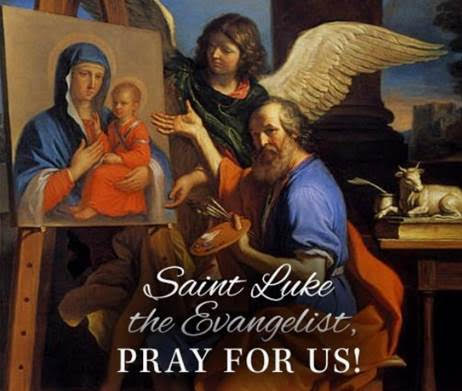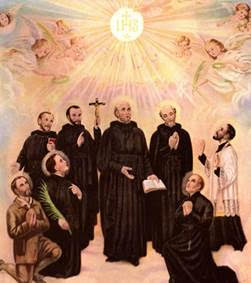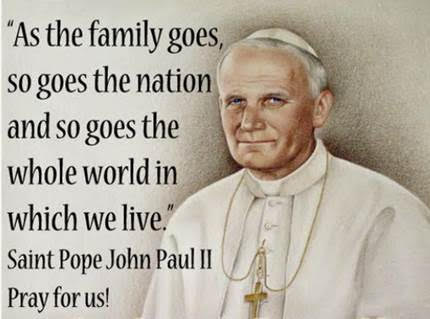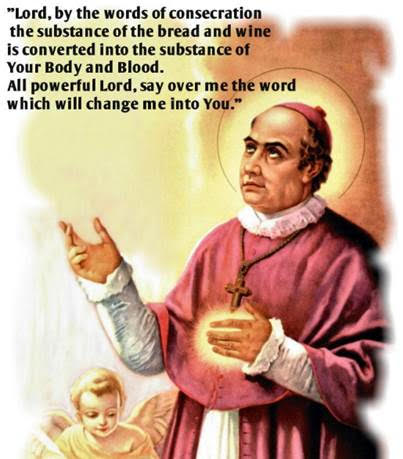Featured Saints for October 18, 2020 Lesson
The Church Has Heroes Too! Another fun thing to learn about, as a Catholic, is our friends, the saints. They may have lived in a different time, and some of these saints had a very difficult life, but all tried to live their life for God.
Sometimes it is good to spend some time learning about other human beings so that we might learn how to love God more. At the end of every story there is a discussion topic for you.

St. Luke Luke was an Evangelist, the writer of the third Gospel. He never met Christ in person, but in his Gospel he says that he came to know about Jesus by talking to eyewitnesses to the events of Jesus’ life, death, and Resurrection. Hearing those stories helped Luke to become a believer, and he wrote his Gospel so that others would come to know and love Jesus.
Luke was a doctor and he traveled with Saint Paul on his second missionary journey. In fact, Paul calls Luke his “beloved physician” (Colossians 4:14). Because he cared for the bodily needs of others, Luke is the patron saint of doctors. He is also the patron saint of artists because it is believed that he painted a famous portrait of Mary, our Blessed Mother.
In his Gospel, Luke helps us to know how concerned Jesus was for the sick, the poor, and anyone in need of help, mercy, and forgiveness. Luke tells us that Jesus came to save all people. Through Luke’s Gospel, we learn how compassionate and caring Jesus was. Some of the most famous stories Jesus told are found in Luke’s Gospel: The Good Samaritan (Luke 10:29-37) and the Lost Son (Luke 15:11-42).
The symbol for Luke’s Gospel is an ox, an animal that was often sacrificed as an offering to God in ancient times. In his writings about Jesus, Luke reminds us of the great sacrifice Jesus made to save all people through his death on the cross and his Resurrection. Luke is also the author of the Acts of the Apostles. In Acts, we learn about the coming of the Holy Spirit; the work of the Apostles, especially Saint Paul; and how the Church grew in the world. He was the one person who was said to have remained with Saint Paul during his imprisonment and until his death.
We celebrate Saint Luke’s service to the Church each year on October 18. We remember that his Gospel continues to help us know and love Jesus. Luke’s Gospel also reminds us to look for ways to imitate Jesus by reaching out to help our brothers and sisters in need. RCL Benziger
Discussion Topic How can you help someone in need this week?

St. Isaac Jogues & Companions Isaac Jogues and his companions were the first martyrs of the North American continent officially recognized by the Church. As a young Jesuit, Isaac Jogues, a man of learning and culture, taught literature in France. He gave up that career to work among the Huron Indians in the New World, and in 1636, he and his companions, under the leadership of Jean de Brébeuf, arrived in Quebec. The Hurons were constantly warred upon by the Iroquois, and in a few years Father Jogues was captured by the Iroquois and imprisoned for 13 months. His letters and journals tell how he and his companions were led from village to village, how they were beaten, tortured, and forced to watch as their Huron converts were mangled and killed.
An unexpected chance for escape came to Isaac Jogues through the Dutch, and he returned to France, bearing the marks of his sufferings. Several fingers had been cut, chewed, or burnt off. Pope Urban VIII gave him permission to offer Mass with his mutilated hands: “It would be shameful that a martyr of Christ not be allowed to drink the Blood of Christ.” Welcomed home as a hero, Father Jogues might have sat back, thanked God for his safe return, and died peacefully in his homeland. But his zeal led him back once more to the fulfillment of his dreams. In a few months he sailed for his missions among the Hurons.
In 1646, he and Jean de Lalande, who had offered his services to the missioners, set out for Iroquois country in the belief that a recently signed peace treaty would be observed. They were captured by a Mohawk war party, and on October 18, Father Jogues was tomahawked and beheaded. Jean de Lalande was killed the next day at Ossernenon, a village near Albany, New York.
The first of the Jesuit missionaries to be martyred was René Goupil who with Lalande, had offered his services as an oblate. He was tortured along with Isaac Jogues in 1642, and was tomahawked for having made the sign of the cross on the brow of some children. Father Anthony Daniel, working among Hurons who were gradually becoming Christian, was killed by Iroquois on July 4, 1648. His body was thrown into his chapel, which was set on fire.
Jean de Brébeuf was a French Jesuit who came to Canada at the age of 32 and labored there for 24 years. He went back to France when the English captured Quebec in 1629 and expelled the Jesuits, but returned to his missions four years later. Although medicine men blamed the Jesuits for a smallpox epidemic among the Hurons, Jean remained with them. He composed catechisms and a dictionary in Huron, and saw 7,000 converted before his death in 1649. Having been captured by the Iroquois at Sainte Marie, near Georgian Bay, Canada, Father Brébeuf died after four hours of extreme torture.
Gabriel Lalemant had taken a fourth vow—to sacrifice his life for the Native Americans. He was horribly tortured to death along with Father Brébeuf. Father Charles Garnier was shot to death in 1649 as he baptized children and catechumens during an Iroquois attack. Father Noel Chabanel also was killed in 1649, before he could answer his recall to France. He had found it exceedingly hard to adapt to mission life. He could not learn the language, and the food and life of the Indians revolted him, plus he suffered spiritual dryness during his whole stay in Canada. Yet he made a vow to remain in his mission until death. These eight Jesuit martyrs of North America were canonized in 1930. Franciscan Media The Eight North American Martyrs (longer story) Catholicism.org
Discussion Topics What do you know about the different North American Indians? Why do you think these men left all the comforts of home to live with the Indians?

St. Pope John Paul II Many people who knew young Karol Wojtyla in Poland thought he might someday be an actor or a writer. Instead, he became pope. Karol Józef Wojtyła was born in the town of Wadowice in Poland in 1920. He was the youngest of three children, and his mother died when he was only nine. When he graduated from high school and went to college, he studied drama. But as World War II approached, the university was closed, and Karol went to work in a quarry and then in a factory to earn money and avoid being sent to Germany to serve in the army.
When he was 22, he realized God was calling him to something different. He knew he wanted to be a priest. But at the time, studying for the priesthood in Poland could only be done secretly, so that is what Karol did. When World War II ended, he was finally able to openly pursue his dream. In 1946, he was ordained a priest.
Karol was a good student and a good priest, and this soon caught the attention of church leaders who sent him to Rome for more study. He later returned to Poland to teach at the seminary. In 1958, he was made a bishop in Krakow, Poland, and just six years later became the archbishop there. By 1967, he had been named a cardinal.
He took part in all of the historical sessions of Vatican II and made important contributions. In 1978, his fellow cardinals elected him pope. He took the name “John Paul II.”
John Paul II was pope for a very long time, nearly 27 years. He traveled the world many times over, going places that popes had not been to before. He danced in Africa. He giggled with children. He cried with dying people. He was a very human and approachable pope. He loved young people so much that he started World Youth Day so he could meet youth from all over the world every few years. The pope was known as a true outdoorsman who loved to ski and hike.
He helped bring about the fall of Communism in Eastern Europe through his preaching and his meetings with heads of state. In 1981, a man named Mehmet Ali Agca shot the pope in St. Peter’s Square. The pope was seriously injured, but quickly asked people to pray for the man who had shot him. He later met personally with Agca to extend his forgiveness. In 2000 during the canonization mass for Maria Faustina Kowalska, Pope John Paul II declared the Second Sunday of Easter as Divine Mercy Sunday. The responsorial psalms for this Mass all have a focus on the theme of mercy.
Pope John Paul II was also a teacher, writing many important documents that educated people about the faith. He wrote five spiritual books of his own, too. After suffering for many years with an illness that weakened him greatly, he died in 2005. More than three million people traveled to Rome to pay their respects to him.
Just a few weeks later, Pope Benedict XVI announced that the usual five-year waiting period before someone could be considered a saint would not be necessary for John Paul II, because his life had clearly been so holy. In 2013 Pope Francis declared that Pope John XXIII and Pope John Paul II were to be formally canonized on the same day. In preparation for the Jubilee Year of Mercy, Pope Francis referred to Saint John Paul II as a great “apostle of mercy” and role model for us today. RCL B
Discussion Topics What do you think about these words of St. Pope John Paul II ““Love of Christ does not distract us from interest in others, but rather invites us to responsibility for them, to the exclusion of no one….”?

St. Anthony Mary Claret Today’s saint was a finely tuned, high-octane engine of evangelization. Anthony Claret was from Catalonia, the region around Barcelona, Spain. He studied for the priesthood in Rome, was ordained in 1835, and then returned to Spain to spend ten years giving missions. In 1849 he founded the Congregation of the Missionary Sons of the Immaculate Heart of Mary, more commonly known as the Claretians in honor of their founder. The Order was particularly focused on publishing works of devotion and piety, books offering spiritual advice, and numerous pamphlets of basic catechesis. The Claretians filled a need and, as publishers, enjoyed enormous success. They published millions and millions of books and pamphlets. And all of this was spearheaded by Anthony, who not only generated doctrinal content but who also mastered the technical details of printing, learned the business side of the industry, and edited the published works himself.
In 1851, when Anthony was appointed the Archbishop of Santiago Cuba, the full array of his talents were put on display. He added the name of “Mary” to his baptismal name at his episcopal consecration and began a remarkably fruitful seven years as Archbishop. He traveled incessantly throughout his territory, restored the seminary, established hospitals and dozens of new parishes, and personally visited the sick and dying. He was ever present and provocative in his pastoral outreach, so much so that attempts were made on his life by the apathetic offended by his success. He was severely injured by one of these attempts but survived. Bishop Anthony was a true man of action. Creative ideas on how to spread the Gospel flowed constantly from his mind. Every tribulation and hardship was, for him, just an invitation to deeper commitment. It was nothing for Anthony to expend all of his energy one day and to wake up and do the same the next day. He was replenished by exhausting himself.
In 1857 he resigned as Archbishop when he was recalled to Spain to become the personal chaplain to the Queen. This more sedentary life was a cross for Anthony, who was a born missionary. But he continued to dedicate himself to apostolic activity as much as his court obligations allowed. At the Royal Monastery outside of Madrid where he was assigned, he set up a science library, a school for music and languages, a museum of natural history, and a fraternity composed of cultural leaders and intellectuals that grew to national prominence. Anthony was such a robust motor of evangelization and cultural advancement that he earned powerful enemies who feared his success. They eventually drove him from Spain to France, where he died in 1870.
Like so many saints, Anthony Mary Claret was a double or triple threat. He was so multi-faceted, so skilled in so many diverse fields that it is hard to believe that one man accomplished so much. He worked well and he worked quickly. Also like many other saints, behind Anthony’s labors was a regimented life of prayer, daily Mass, the rosary, fasting, spiritual reading, self-discipline and moral strictness. He was perpetually in the presence of God, and in his later years experienced spiritual ecstasies and performed miraculous healings. This incredible man of action and prayer was canonized in 1950. Catholic Life
Discussion Topic Describe an incredible man or women that you know. What makes them so important?
More Saint Information
Read more about popular saints from Catholic Online.
You might want to incorporate a coloring page. Saint Coloring Pages for Kids
Optional activities and resources that compliment this lesson can be found on the links below.
God’s Word
Featured Saints
Family Activities
Additional Videos and Resources
Lesson Theme